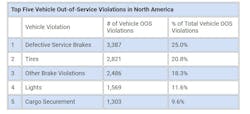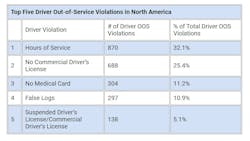International Roadcheck, the Commercial Vehicle Safety Alliance’s annual commercial motor vehicle inspection and regulatory compliance enforcement initiative, occurred this year May 14-16. Several months later, the results of this event have been released.
In some areas, International Roadcheck yielded results most of the industry could likely predict. But other results just lead to more questions. This article will dive into the results of International Roadcheck and highlight what they could mean for the industry.
The expected results
Vehicle violations
According to CVSA, 9,299 vehicles were placed out of service in North America during International Roadcheck. A total of 3,387 of these were placed out of service for defective service brakes, the top vehicle violation in North America over the course of the event.
“Defective service brakes can prevent a driver from stopping quickly and/or completely,” CVSA said on its website. “When brakes fail, the results can be catastrophic, not only for the driver, but for everyone on our roadways.
This top violation showcases the need for more and better pre-trip inspections and preventive maintenance programs, according to Jim Ward, senior safety manager at Transervice Logistics.
The remaining top vehicle violations in North America during International Roadcheck were:
- Tires
- Other brake violations
- Lights
- Cargo securement
Additionally, part of CVSA’s focus this Roadcheck was on tractor protection systems, which “safeguard the tractor’s air supply and prevent air loss when the tractor is not connected to a trailer or if the trailer breaks away.” During International Roadcheck, 564 TPS violations were discovered.
See also: Marijuana testing bottlenecks commercial driver availability
Driver violations
According to CVSA, 2,290 commercial motor vehicle drivers were placed out-of-service during International Roadcheck in North America. Thirty-two percent of these cases were for hours-of-service violations, equaling 870 drivers.
“Hours-of-service regulations state the maximum amount of time commercial motor vehicle drivers are permitted to be on duty, including driving time, and specify the number and length of rest periods,” CVSA said on its website. “These regulations are in place to prevent crashes caused by driver fatigue; to protect drivers’ quality of life, health and wellbeing; and to ensure road safety.”
The remaining top driver violations in North America during International Roadcheck were:
- No CDL
- No medical card
- False logs
- Suspended driver’s license/CDL
During this year’s Roadcheck, CVSA focused on alcohol and controlled-substance possession for drivers. Overall, 78 drug and 26 alcohol possession/use out-of-service violations were discovered. Additionally, 63 drivers were placed out of service for operating vehicles despite being listed in the FMCSA’s Drug & Alcohol Clearinghouse.
FMCSA’s Drug & Alcohol Clearinghouse is a working federal database for drivers who have violated federal drug and alcohol testing requirements. Clearinghouse data is limited to only a few years, heavily disrupted by an unusual freight cycle since the pandemic. However, positive tests in recent years have been declining.
Overall drug violations are trending down over the last two years. The number of drug violations in the Drug & Alcohol Clearinghouse fell since 2022, when drug violations peaked at 57,508. In 2023, violations dipped to 54,159.
CVSA also focused on seat belt usage for drivers this year. A total of 535 safety belt violations were issued during this year’s International Roadcheck.
The unexpected results
When you look at the individual results for International Roadcheck, nothing is too surprising; defective service brakes and hours of service were common issues in past Roadchecks, and drug use and testing has been a controversial issue in the industry for a while.
But if you look at the bigger picture, the statistics of this year’s Roadcheck are intriguing. This year, 48,761 inspections were conducted. But in 2023, there were 59,429 inspections. In 2022, 59,026. This brings up multiple questions:
- Why were fewer inspections conducted during this year’s Roadcheck?
- With fewer inspections, are this year’s results a clear picture of the industry?
- Will this trend continue in 2025?
According to Ward, it’s possible that there were just fewer inspectors and officers available during International Roadcheck this year.
About the Author

Jenna Hume
Digital Editor
Digital Editor Jenna Hume joined FleetOwner in November of 2023 and previously worked as a writer in the gaming industry. She has a bachelor of fine arts degree in creative writing from Truman State University and a master of fine arts degree in writing from Lindenwood University. She is currently based in Missouri.


